BUAL Operation as a Conservative Treatment of Refractory Menorrhagia
Bilateral Uterine Artery Ligation (BUAL) Operation as a Conservative Treatment of Refractory Menorrhagia
Introduction:
Only a small rang of medical treatment are available for menorrhagia, of limited or no benefit, usually failing and leaving no option between putting up with the symptoms and hysterectomy. For a while there was an optimism that ablation of endometrium (EA) could reduce the hysterectomy rate dramatically, but enthusiasm waned when it appeared that the procedure was not without complications as bleeding disorders returned in over one third of cases often necessitating hysterectomy. EA was also unsuitable to apply in both virgins and infertile young women, as there was a high chance of serious obstetric complication if pregnancy happened. It is well known that transvaginal procedures in virgins are never accepted in Middle East due to moral and religious reasons.
The novel operation of bilateral uterine artery ligation (BUAL operation) that introduced by the author for the first time as an alternative to hysterectomy in April 1999.
Patient and methods:
The study included 30 cases with refractory menorrhagia who were advised to contemplate hysterectomy in virgins (8 cases) or relatively young women (22 cases) with mean age of 30 years (19-41 range). In whom all types of therapy as medical, hormonal, repeated D&C or myomectomy had failed to control the bleeding. Adenomyosis was present in diffuse or localized type in 12 cases proved by imaging studies and needle biopsy of the myometrium during the operation. Atypia in the cervix or endometrial hyperplasia are the major contraindication to BUAL operation and excluded from the study.
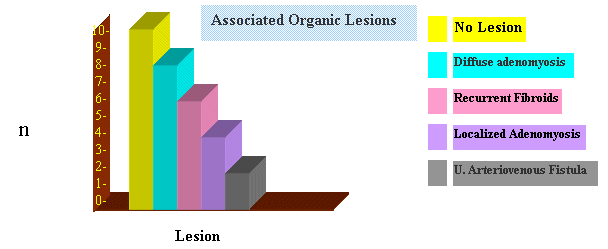
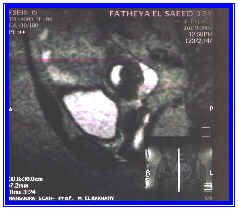
Fig. 1a
MRI shows diffuse adenomtosis
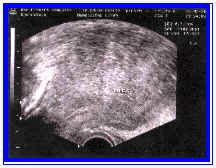
Fig. 1b
Diffuse adenomyosis by T.V.S with small myometrial cystic spaces and distorted endometrial plates
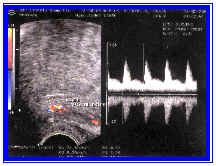
In the same case by T.V.C.D.S low RI of the uterine artery (0.67)
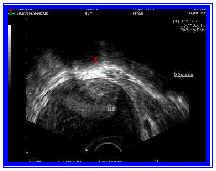
Localizes adenomyosis T.V.S localized posterior wall lesion with cystic spaces.

In the same case T.V.C.D.S low RI values of the uterine artery (0.75)
Preoperative Laboratory evaluations include CBC with platelets count, bleeding time, prothombin time, APTT, Liver, renal, thyroid function tests, cervical cytology should be negative and endometrium should be secretory. Hormonal therapy if had been taken should end at least 2 weeks before the operation.
The operation can be performed through laparoscopy or minilaparotomy taking not more than 40 minutes.
The operation was started during the attacks of bleeding in 9 cases to get sure that the bleeding was heavy and to record the result as early as possible.
A transverse lower abdominal skin incision was used and after opening the peritoneum by the left hand the head of the table then lowered, the intestine was packed away of the field, a large tapered needle with 1-0 silk then passed 1cm medial to the vessels at the level of the isthmus in front of the to back manner leaving the cervical branch and the first few raw of the arcuate arteries, the needle was next passed anteriorly back to front through the vascular area of the broad ligament and tied. A similar procedure was carried on the contra lateral side. Both artery and vein were doubly ligated the artery was incised in between the 2 ligature to decrease the possibility of recanalisation .The wound then closed.
The meantime taken was 55 minutes (45-71 minutes average) patient usually spend 36 hours in hospital and were advised to take 10 days off work.
Associated operation:
Associated removal of 2 subserous pedunculated fibroid to prevent necrosis was performed in one case and resection of a localized adenomyoma 4x5 Cm in another case.
Result:
The bleeding and pain were controlled in most of cases (94%)with return of the normal menstruation. In cases of adenomyosis the mean uterine volume was decreased by 35%. Doppler flowmetry of the uterine blood flow proved to be within its normal values shortly after the operation (RI, PI & Peak systolic velocity). Ovarian functions are maintained as proved by serial folliculometry. Pregnancy after the operation was recorded in 7 cases that have been treated for adenomyosis four cases of them had completed their pregnancy without complications, one case still in 32 weeks another case in25 weeks of pregnancy both have normal Color Doppler studies, one case had aborted in 7 weeks of pregnancy. Other pregnancies occurred in women with/without other pelvic pathology than adenomyosis.
Both serial early and late CD studies revealed, normal blood flow indices in uterine arcuate, intramyometrial and spiral arteries and arterioles as shown in the following figures.
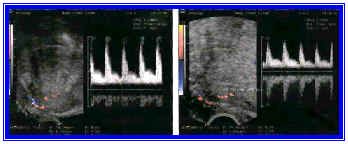
Early postoperative CD in one of the cases

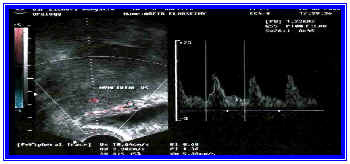
CD. Of the intramyometrial arterioles one year after the operation RI. 0.68,
Results of Sonographic and Color Doppler Study
After the First Year of the Operation
Items
n Studied
Results
RI =Resistance Index
After the Operation (n30)

Results
After >2 years of follow up most of the patients are still satisfied with the operation results especially as regard the bleeding control and pain improvement, However maximum improvement is not seen until 4-6 months.
Discussion:
One half of the women that have hysterectomy for menorrahgia have a normal uterus removed and more than 44% of women with conserved ovaries after hysterectomy had developed climacteric symptoms before the age of 54 years and 50% of them within two years of hysterectomy (Clork et al 1995). The aim of this work was to treat refractory uterine bleeding leaving an intact uterus.
Menorrahgia is closely linked through its eatiopathogenesis to infertility. Management of menorrahgia with infertility is a major challenge to the specialists especially after repeated surgical failure as repeated D&C or myomectomy. BUAE was refused by the group of this study for fear of irradiation hazards on the ovaries, however two patients had accepted the trial of BUAE but not included in this study. It is estimate that the radiation dose to the patient during BUAE was 25m.sv with 30 minutes exposure which equivalent to 3 1/2 times the dose of barium enema (Walker 1999), a fact which needing a more studies on the effect of irradiation in old stored numbers of oocytes in such infertile women.
To the best of our knowledge, this is the first trial for the treatment of refractory menorrahgia by surgical BUAL.
Conclusion:
The operation is found to be promising as an alternative to hysterectomy especially suitable for relatively young females for whom hysterectomy was indicated. After more than 2 years of follow up most of the women are still satisfied with the operation results.
References:
References:
1-Clarke A., Black N, Rowe P et al (1995):Indications for and outcome of total abdominal hysterectomy for benign disease: a prospective cohort study. Br. J obstet Gynecol 102:611-620.
2-Popp Lw: Schwiedesen JP, Gaeetje R (1993): Myometrial biopsy in the diagnosis of the adenomyosis uteri. Am obstet Gynecol 169: 546-549.
3-Ravina JA, Herbreteu D, Cirara Vigneron N et al (1995): Arterial embolization to treat uterine myomata. Lancet 346:671-672.
4-Walker W J (1999): Bilateral uterine artery embolization for fibroid: Quoted from "menorrhagia"by Shirish Sheth & Christopher Sutton. ISIS Medical Media Ltd, Oxford Chap 16.P 188.
5-Whitelaw NL, Sutton CJC (1993): Pregnancy following endometrial ablation. Gynecol Endosec. 1:92-132.
Prof. Dr. Refaat I. El_Shimy
Mobile/+20123562581, Tel/+202498271
Fax/+2057404035
E-mail (prof_shimydam@yahoo.com)
S1E4: Dr. Kristina Adams-Waldorf: Pandemics, pathogens and perseverance
July 16th 2020This episode of Pap Talk by Contemporary OB/GYN features an interview with Dr. Kristina Adams-Waldorf, Professor in the Department of Obstetrics and Gynecology and Adjunct Professor in Global Health at the University of Washington (UW) School of Medicine in Seattle.
Listen
